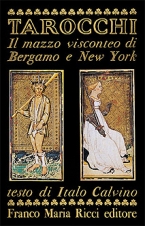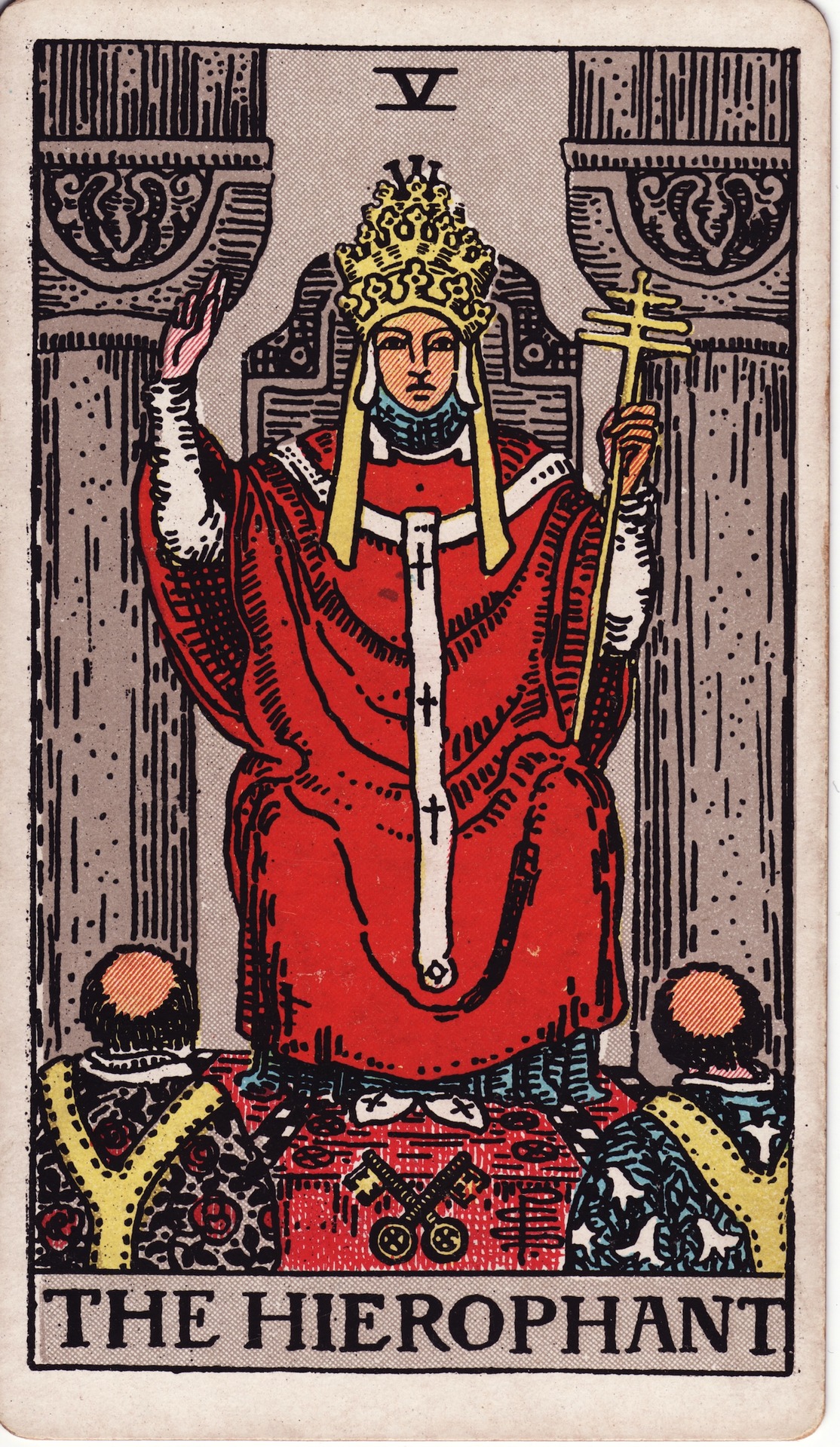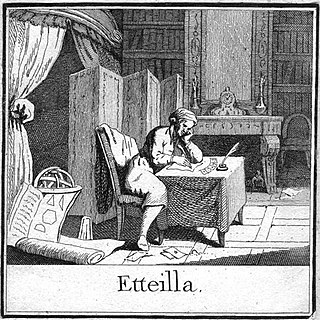
Tarot is a pack of playing cards, used from at least the mid-15th century in various parts of Europe to play card games such as Tarocchini. From their Italian roots, tarot-playing cards spread to most of Europe, evolving into a family of games that includes German Grosstarok and modern games such as French Tarot and Austrian Königrufen. In the late 18th century French occultists made elaborate, but unsubstantiated, claims about their history and meaning, leading to the emergence of custom decks for use in divination via tarot card reading and cartomancy. Thus, there are two distinct types of tarot packs in circulation: those used for card games and those used for divination. However, some older patterns, such as the Tarot de Marseille, originally intended for playing card games, are occasionally used for cartomancy.

The Castle of Crossed Destinies is a 1973 novel by Italian writer Italo Calvino.

Arthur Edward Waite was a British poet and scholarly mystic who wrote extensively on occult and esoteric matters, and was the co-creator of the Rider–Waite tarot deck. As his biographer R. A. Gilbert described him, "Waite's name has survived because he was the first to attempt a systematic study of the history of Western occultism—viewed as a spiritual tradition rather than as aspects of protoscience or as the pathology of religion."

Cartomancy is fortune-telling or divination using a deck of cards. Forms of cartomancy appeared soon after playing cards were introduced into Europe in the 14th century. Practitioners of cartomancy are generally known as cartomancers, card readers, or simply readers.

The Major Arcana are the named or numbered cards in a cartomantic tarot pack, the name being originally given by occultists to the trump cards of a normal tarot pack used for playing card games. There are usually 22 such cards in a standard 78-card pack, typically numbered from 0 to 21. The name is not used by tarot card game players.

The Magician (I), also known as The Magus or The Juggler, is the first trump or Major Arcana card in most traditional tarot decks. It is used in game playing and divination; in the English-speaking world, the divination meaning is much better known.

The Hierophant (V) is the fifth card of the Major Arcana in occult Tarot decks. It is derived from the historical card known as the Pope in playing card decks. It is used in divination. The name refers to a hierophant (Ancient Greek: ἱεροφάντης), a person who brings religious congregants into the presence of that which is deemed "holy".

Pamela Colman Smith, nicknamed "Pixie", was a British artist, illustrator, writer, publisher, and occultist. She is best-known for illustrating the Rider–Waite tarot deck for Arthur Edward Waite. This tarot deck became the standard among tarot card readers, and remains the most widely used today. Smith also illustrated over 20 books, wrote two collections of Jamaican folklore, edited two magazines, and ran the Green Sheaf Press, a small press focused on women writers.

"Etteilla", the pseudonym of Jean-Baptiste Alliette, was the French occultist and tarot-researcher, who was the first to develop an interpretation concept for the tarot cards and made a significant contribution to the esoteric development of the tarot cards to a wide audience, and therefore the first professional tarot occultist known to history who made his living by card divination. Etteilla also influenced the French divination professional Marie Anne Lenormand. In the years 1783–1785 Etteilla published his work Manière de se récréer avec le jeu de cartes nommées tarots, which is still considered the standard reference work of Tarot cartomancy. Etteilla published his ideas of the correspondences between the tarot, astrology, and the four classical elements and four humors, and in 1789 he published his own tarot deck, which, however, differed significantly from the classic tarots such as the Tarot de Marseille in terms of structure and card designations.

Strength is a Major Arcana tarot card, and is numbered either XI or VIII, depending on the deck. Historically it was called Fortitude, and in the Thoth Tarot deck it is called Lust. This card is used in game playing as well as in divination.

Temperance (XIV) is one of the 22 Major Arcana cards in Tarot decks. It is usually numbered 14. It depicts a figure which represents the virtue Temperance. Along with Justice and Strength, it is one of three Virtues which are given their own cards in traditional tarot. It is used in both game playing and in divination.

Marie Anne Adelaide Lenormand (1772–1843), also known as Marie Anne Le Normand, was a French bookseller, necromancer, fortune-teller and cartomancer of considerable fame during the Napoleonic era. In France, Lenormand is considered as the greatest cartomancer of all time, highly influential on the wave of French cartomancy that began in the late 18th century.

The Visconti-Sforza Tarot is used collectively to refer to incomplete sets of approximately 15 decks from the middle of the 15th century, now located in various museums, libraries, and private collections around the world. No complete deck has survived; rather, some collections boast a few face cards, while some consist of a single card. They are the oldest surviving tarot cards and date back to a period when tarot was still called Trionfi cards, and used for everyday playing. They were commissioned by Filippo Maria Visconti, Duke of Milan, and by his successor and son-in-law Francesco Sforza. They had a significant impact on the visual composition, card numbering and interpretation of modern decks.

The Mantegna Tarocchi, also known as the Tarocchi Cards, Tarocchi in the style of Mantegna, Baldini Cards, are two different sets each of fifty 15th-century Italian old master prints in engraving, by two different unknown artists. The sets are known as the E-series Tarocchi Cards and the S-series Tarocchi Cards, and their artists are known as the “Master of the E-series Tarocchi” and the “Master of the S-series Tarocchi”. There are also a number of copies and later versions. Despite their name, they are educational visual aids, showing personifications of social classes or abstractions.

Tarot card reading is a form of cartomancy whereby practitioners use tarot cards to purportedly gain insight into the past, present or future. They formulate a question, then draw cards to interpret them for this end. A traditional tarot deck consists of 78 cards, which can be split into two groups, the Major Arcana and Minor Arcana. French-suited playing cards can also be used; as can any card system with suits assigned to identifiable elements.

The Tarot Garden is a sculpture garden based on the esoteric tarot, created by the French-American artist Niki de Saint Phalle (1930–2002) in Pescia Fiorentina, località Garavicchio, in the municipality of Capalbio, province of Grosseto, Tuscany, Italy. The park was opened to the public in 1998.
Rosemary Ellen Guiley was an American writer on topics related to spirituality, the occult, and the paranormal. She was also a radio show host, a certified hypnotist, a board director of the "National Museum of Mysteries and Research" and the "Foundation for Research into Extraterrestrial Encounters", and a "Lifetime Achievement Award" winner from the Upper Peninsula Paranormal Research Society, Michigan. She has written more than 49 books, including ten encyclopedias.

Tarot games are card games played with tarot packs designed for card play and which have a permanent trump suit alongside the usual four card suits. The games and packs which English-speakers call by the French name Tarot are called Tarocchi in the original Italian, Tarock in German and similar words in other languages.

The Fool is one of the 78 cards in a tarot deck. In tarot card reading, it is one of the 22 Major Arcana, sometimes numbered as 0 or XXII. However, in decks designed for playing traditional tarot card games, it is typically unnumbered, as it is not one of the 21 trump cards and instead serves a unique purpose by itself.

The Sola Busca tarot is the earliest completely extant example of a 78-card tarot deck. It is also the earliest tarot deck in which all the plain suit cards are illustrated and it is also the earliest tarot deck in which the trump card illustrations deviate from the classic tarot iconography. Unlike the earlier Visconti-Sforza tarot decks, the cards of the Sola Busca are numbered. The trump cards have Roman numerals while the pips of the plain suits have Hindu Arabic numerals.The deck was created by an unknown artist and engraved onto metal in the late 15th century. A single complete hand-painted deck is known to exist, along with 35 uncolored cards held by various museums. The deck is notable not only for its age, but also for the quality of its artwork, which is characterized by expressive figures engraved with precise contours and shading. Various theories have been suggested about who created the deck, but its authorship remains uncertain.



















